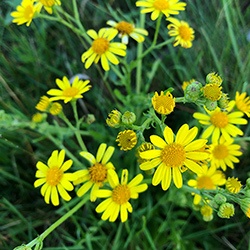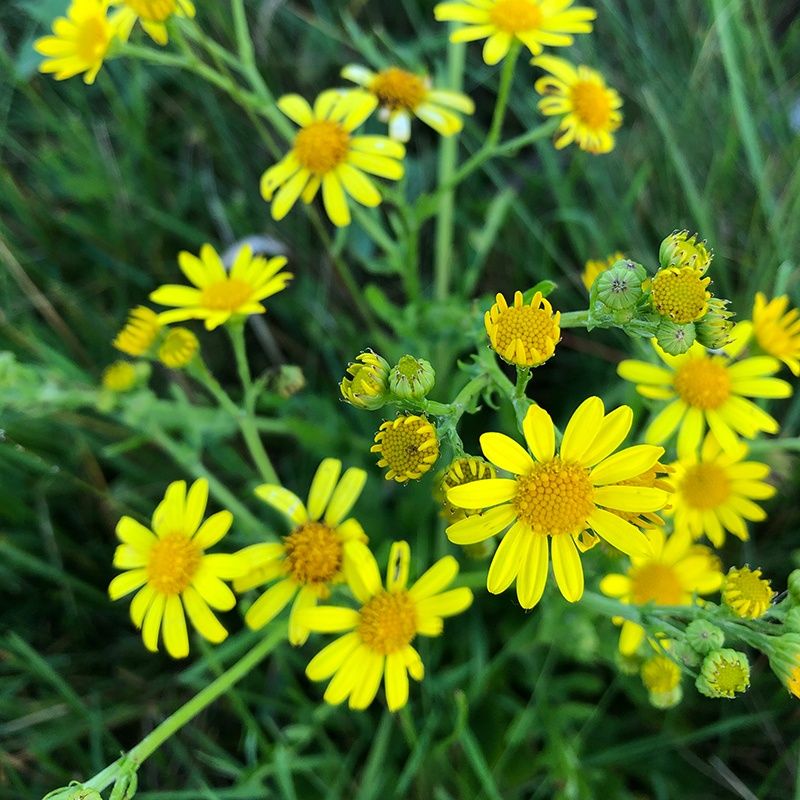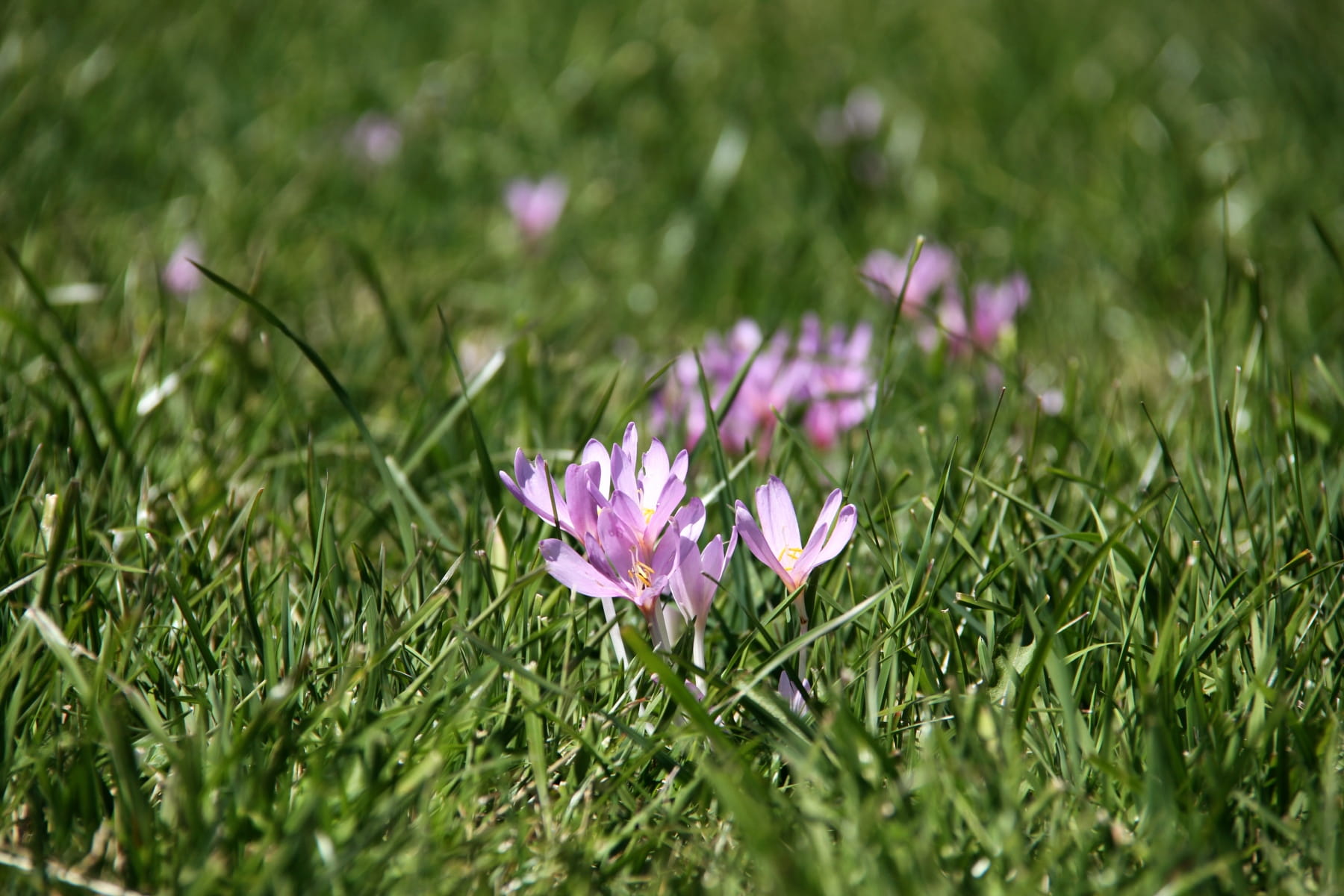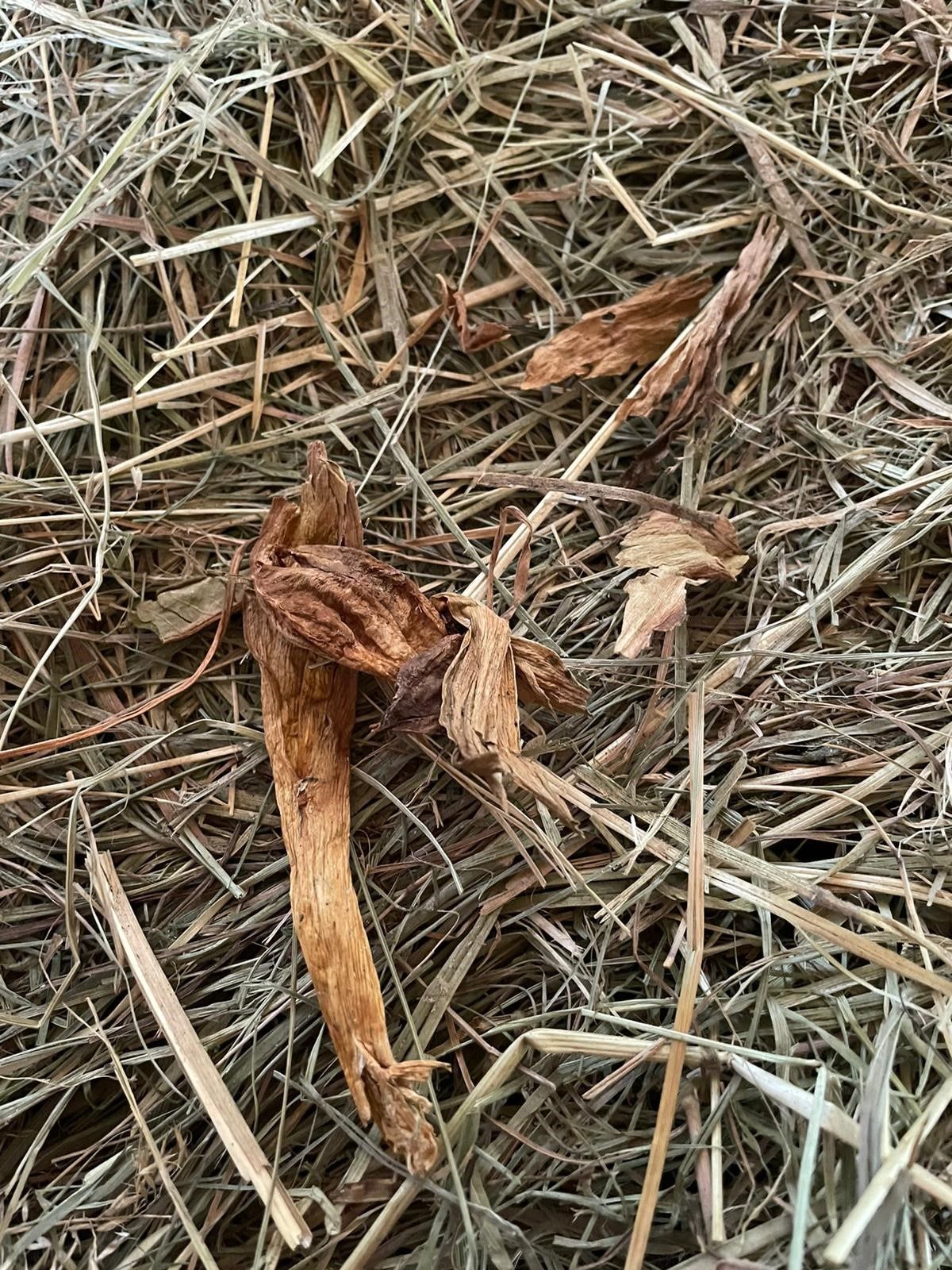
Caution: Poisonous Plants!
Many plants can cause toxic reactions if ingested. Horses will generally avoid most poisonous plants growing in horse pastures. A scarce food supply, however, can lead to horses grazing on these poisonous plants. There is also the danger of young, inexperienced horses grazing on poisonous plants instead of around them.
Most poisonous plants lose their toxicity when they are cut and dried or ensiled. It can be especially dangerous, therefore, when those plants that still have toxic effects even when dried or ensiled find their way into the horse's forage. Such processing will cause these plants to lose their bitter taste, and horses will more readily eat them.
Common ragwort (Senecio jacobaea)
Amongst poisonous plants, the highly toxic common ragwort is of particular note. The prevention of this plant's spread on pastures and fields is of great importance.
Common ragwort is found frequently in moderately maintained grasslands, but it also grows in fallow and greenfield areas as well as along roads and railway embankments. Its spread is helped by insufficient maintenance, overuse, or underuse of grassland as well as weakened turf.
Common ragwort belongs to the Asteraceae family, with corymbs of 15 to 20 yellow flower heads. The base of the stem has a reddish-purple colour; the rest of it is green. The stem is 20 to 130 cm long, depending on the height of the plant. Common ragwort flowers from June to October, with the main flowering period occurring around 25th July (St James's Day, hence jacobaea in the name). Its seeds are spread primarily by the wind and can remain dormant in the soil for up to 25 years. There are other varieties of ragwort in addition to common ragwort, including marsh ragwort, alpine ragwort, and wood ragwort, all of them poisonous.
 What makes ragworts so toxic? In their green, unharvested state, these ragworts contain pyrrolizidine alkaloids (PAs); these substances serve to keep herbivores from grazing on the plants, as doing so can lead to acute or chronic poisoning. PAs are primarily known for their liver toxicity. Ingested PAs accumulate in the liver, meaning that repeated ingestion of even small quantities can lead to fatal poisoning. Symptoms of chronic poisoning include loss of appetite, weight loss, and lethargy. Horses react especially sensitively to the toxins in common ragwort. Ingestion of just 20–40 kg of this plant in its fresh state (or 3.4 kg dried and mixed in hay) can have fatal consequences for a 500 kg horse. PAs can be found in other plants, however, so high levels of PA do not necessarily detect the presence of common ragwort in forage.
What makes ragworts so toxic? In their green, unharvested state, these ragworts contain pyrrolizidine alkaloids (PAs); these substances serve to keep herbivores from grazing on the plants, as doing so can lead to acute or chronic poisoning. PAs are primarily known for their liver toxicity. Ingested PAs accumulate in the liver, meaning that repeated ingestion of even small quantities can lead to fatal poisoning. Symptoms of chronic poisoning include loss of appetite, weight loss, and lethargy. Horses react especially sensitively to the toxins in common ragwort. Ingestion of just 20–40 kg of this plant in its fresh state (or 3.4 kg dried and mixed in hay) can have fatal consequences for a 500 kg horse. PAs can be found in other plants, however, so high levels of PA do not necessarily detect the presence of common ragwort in forage.
Prognoses for acute poisoning from PAs are mostly poor, with treatments being frequently ineffective. In the case of chronic poisoning, depending on the extent of organ damage, recovery may be possible through symptomatic liver treatment and stopping further ingestion of common ragwort or other PAs.
However, increased levels of PAs are being found not only in animal feeds but in herbal teas and honey as well.
Meadow saffron – (Colchicum autumnale)
 The meadow saffron is another highly toxic plant which grows on extensively cultivated grasslands. It is less commonly found on areas subject to intensive agriculture, i.e. to early and frequent cuttings. Horse pastures and grassland cultivated for horse hay are subject to extensive maintenance, and so horses are particularly exposed to potential harm from this poisonous plant. Periodically wet meadows with nutrient-rich loamy soils offer the meadow saffron optimum conditions for it to thrive.
The meadow saffron is another highly toxic plant which grows on extensively cultivated grasslands. It is less commonly found on areas subject to intensive agriculture, i.e. to early and frequent cuttings. Horse pastures and grassland cultivated for horse hay are subject to extensive maintenance, and so horses are particularly exposed to potential harm from this poisonous plant. Periodically wet meadows with nutrient-rich loamy soils offer the meadow saffron optimum conditions for it to thrive.
This admittedly pretty plant belongs to the lily family and poses several hazards that horse owners, livery yard operators and farmers should be aware of.
- Unlike common ragwort, which one can usually recognise clearly just before the first cutting, meadow saffron hides in the dense short grasses just above the sward. It always has three leaves, which can grow to 30 cm long, but most fall far short of that length.
Its seed capsules begin to form in May, well concealed between the leaves.
The plant flowers in autumn, generally in September – hence its other name, autumn crocus – when the light purple, crocus-like flowers can be seen everywhere in the shorter grass.
If you want to eliminate this rapidly spreading plant from your pasture or fields, you need to act as quickly as possible. Ideally either in April, when the first dark green leaves are visible in the still-short grass, or in autumn when the flowers appear. The most effective method for long-term removal is by digging them out or by mulching, especially in April and May when the bulb's energy reserves are at their lowest. In autumn, mowing or mulching will impede their spread, but the bulbs will simply grow again in the spring.
Always wear gloves when digging out meadow saffron by hand, as all parts of the plant are poisonous. Dispose of the plants with general waste. However, the highest toxicity is found in the seed capsules, which reach full maturity just before the first cutting for horse hay in June.  Another factor is the plant's toxicity in dried or ensiled form. Meadow saffron is just as toxic dried as it is fresh.
Another factor is the plant's toxicity in dried or ensiled form. Meadow saffron is just as toxic dried as it is fresh.
Meadow saffron has an alkaloid content of 1.2–2%. It contains a total of 20 different alkaloids, which is why toxic reactions vary so greatly in affected animals. Particularly dangerous is the cytotoxin colchicine, which can lead to acute and severe poisoning if consumed in large quantities and can lead to colics, laminitis, and neurological disorders. Particularly insidious, however, is the poison's slow accumulation in the body. Daily ingestion of even the smallest quantities of this cytotoxin will lead to its accumulation in the liver and kidneys, resulting in muscle atrophy and severe organ damage.
The acute lethal dose in horses is 1 mg/kg, corresponding to about 400 g of the dried plant and 1.5–2.5 kg in its fresh form. The alkaloid content increases as the plant matures, so the later the plant is harvested with the hay, the more colchicine it will contain – another reason why it especially affects horses that are given hay that is cut extremely late.
As with common ragwort, the prognosis for acute poisoning from meadow saffron is rather poor, as respiratory paralysis almost always occurs. Chronic cases can be alleviated with concomitant treatment to support the detoxification organs. It is crucial, however, that no further parts of the plant be ingested.
In any case, it is highly recommended that preventive measures be taken to stop the spread of these plants to keep them out of the feed. Regular and consistent pasture management is therefore important to promote the maintenance of a dense sward made up of highly competitive plant species. Preventive and mechanical means of combating toxic plants include alternating use of the field as hayfield and pasture. Regular second-growth mowing and harrowing are also effective measures. Early mulching (especially for meadow saffron), fertilisation as needed, and early reseeding of bare patches with a suitable seed (such as Pre Alpin® Saatgut) can also help to successfully eliminate these plants from your field.
Consistent maintenance should be carried out on pastures and meadows, and grasslands or arable crops such as lucerne should be cultivated specifically to control common ragwort. Here, too, poor maintenance of cultivated areas can lead to the spread of poisonous plants – especially if these areas are extensively managed as grasslands and not as crop lands subject to constant maintenance.
AGROBS quality control for poisonous plants
The control of poisonous plants is a special and important issue for us with regard to the production of animal feed.Our quality control is structured as follows for poisonous plants such as common ragwort:
1. Information
b. Supply agreements with provisions for the reporting, containment of area and control of poisonous plants.
c. Information provided to riding stables and farmers on sighting poisonous plants.
2. Inspection
ii. Soil properties
iii. General field maintenance
3. Control
b. Information to non-supplying farmers and authorities who identify poisonous plants growing on their land.
As a roughage producer and agricultural business, we will continue to contribution as best we can to the production of healthy and high-quality roughage.
We hope, however, that the public will become fully aware of this information about common ragwort and its control, and that common ragwort will soon be subject to statutory declaration.
Dr. med. vet. Katharina Boes
April 2021 ©AGROBS GmbH
Sources*:
- The Chamber of Agriculture of North Rhine-Westphalia: Jakobskreuzkraut (Senecio jacobaea) - Eine Giftpflanze auf dem Vormarsch. 4th Edition, Version from November 2012
- Gottschalk C., Ostertag J., Meyer K., Gareis M.: Pyrrolizidinalkaloide in Futtermitteln. Presentation given at the 16th BfR Consumer Protection Forum 2015 Berlin
- German Federal Institute for Risk Assessment: Pyrrolizidinalkaloide in Kräutertees und Tees. Opinion 018/2013 of the BfR from 05 July 2013
- Meyer H., Coenen M.: Pferdefütterung. Enke Verlag, Stuttgart 2014
- Seither, M., Elsäßer, M. (abgerufen 2021), Bekämpfungsstrategien gegen Herbstzeitlose (Colchicum autumnale) und deren Auswirkungen auf die botanische Zusammensetzung artenreicher Wiesen, Landwirtschaftliches Zentrum für Rinderhaltung, Grünlandwirtschaft, Milchwirtschaft, Wild und Fischerei Baden-Württemberg, Atzenberger Weg 99, 88326 Aulendorf
- Gehring, K., Thyssen, S. (2004): Unkraut-Steckbrief: Herbstzeitlose, Bayerische Landesanstalt für Landwirtschaft (LFL)
- Brand, Stephan (2020), Herbstzeitlose – jetzt Flächen für die Frühjahrsbekämpfung ermitteln, online abzurufen: https://llh.hessen.de/pflanze/pflanzenschutz/herbstzeitlose-jetzt-flaechen-fuer-die-fruehjahrsbekaempfung-ermitteln/



